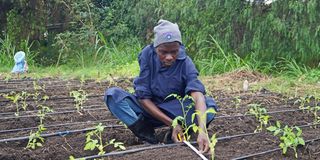Agronomist notebook: Gapping, scouting for pests on tomato farm

A worker checks on tomato plants on a farm in Kajiado County.
What you need to know:
- Seedlings fail to take off due to various reasons, among them transplanting shock, inadequate water that results in drying, or excess water that creates a conducive environment for damping-off, a fungal infection that affects seedlings.
- Damping-off refers to the rotting of the stem and the root tissues at and below the soil surface.
- Scouting should be done at least once or twice per week. In our case, we shall use the zigzag method the entire season of crop management.
- It is important to check the entire plant because pests such as Tuta absoluta affect the leaves, stems and the fruits.
It is over a week since farmer Moses transplanted his tomatoes; so far, so good.
But as expected, one cannot achieve 100 per cent success rate after transplanting. Some seedlings die, others start the journey very weak.
They must, therefore, be replaced with healthy ones – what is known as gapping. The process helps in attaining a 100 per cent population.
Gapping also ensures efficient use of inputs provided in the field hence maximising yields.
Seedlings fail to take off due to various reasons, among them transplanting shock, inadequate water that results in drying, or excess water that creates a conducive environment for damping-off, a fungal infection that affects seedlings.
Damping-off refers to the rotting of the stem and the root tissues at and below the soil surface.
Cutworms also affect the young seedlings, thus, one should check on the soil surface next to the stem to identify the presence of the cutworms.
Thus, this past week we have been doing gapping, alongside other management practices. We first started with scouting for dead seedlings, then removed as we counted them. Luckily, they were not many.
The seedlings to replace them were those that remained in the nursery bed after we transplanted. We used the same transplanting procedure discussed last week.
After gapping, we ensured the new seedlings received adequate water. We also scouted for pests and diseases to identify them early for easy management.
Through scouting, one identifies and monitors pests, diseases, weeds and water to apply appropriate preventative measures.
Scouting should be done at least once or twice per week. In our case, we shall use the zigzag method the entire season of crop management.
This starts by identifying the scouting points to represent the entire block and following the zig-zag pattern.
Management practices
While scouting for pests and diseases, the upper and lower parts of leaves should be checked.
It is important to check the entire plant because pests such as Tuta absoluta affect the leaves, stems and the fruits.
Some deficiency symptoms appear on the lower sides of the plant such as magnesium and nitrogen while iron appears on the plant shoots.
Scouting is preferably done early morning or late evening. This is because most pests are active at night or in the evening.
During scouting, Moses also checked if the crops were receiving adequate water. The moisture test is done by pressing the soil on the palm; if it gets sticky and easily forms a ball, then one may not need to water the crops.
I also showed Moses how to scout for physiological disorders that are likely to affect tomatoes. This include the blossom end rot and sun scalding.
For blossom end rot, one should check the plants for slightly sunken leathery areas around the tip end of the fruit that appears water-soaked or coloured brown.
For sun scalding, the fruits appear whitish on the side or the upper part.It is also important to scout for weeds.
Through scouting, Moses was able to know the next course of action and plan accordingly for the labour on the farm.
On the left is a scouting form I developed for Moses to use the entire season.
In our next article, we shall look at crop support (staking) as part of the management practices





